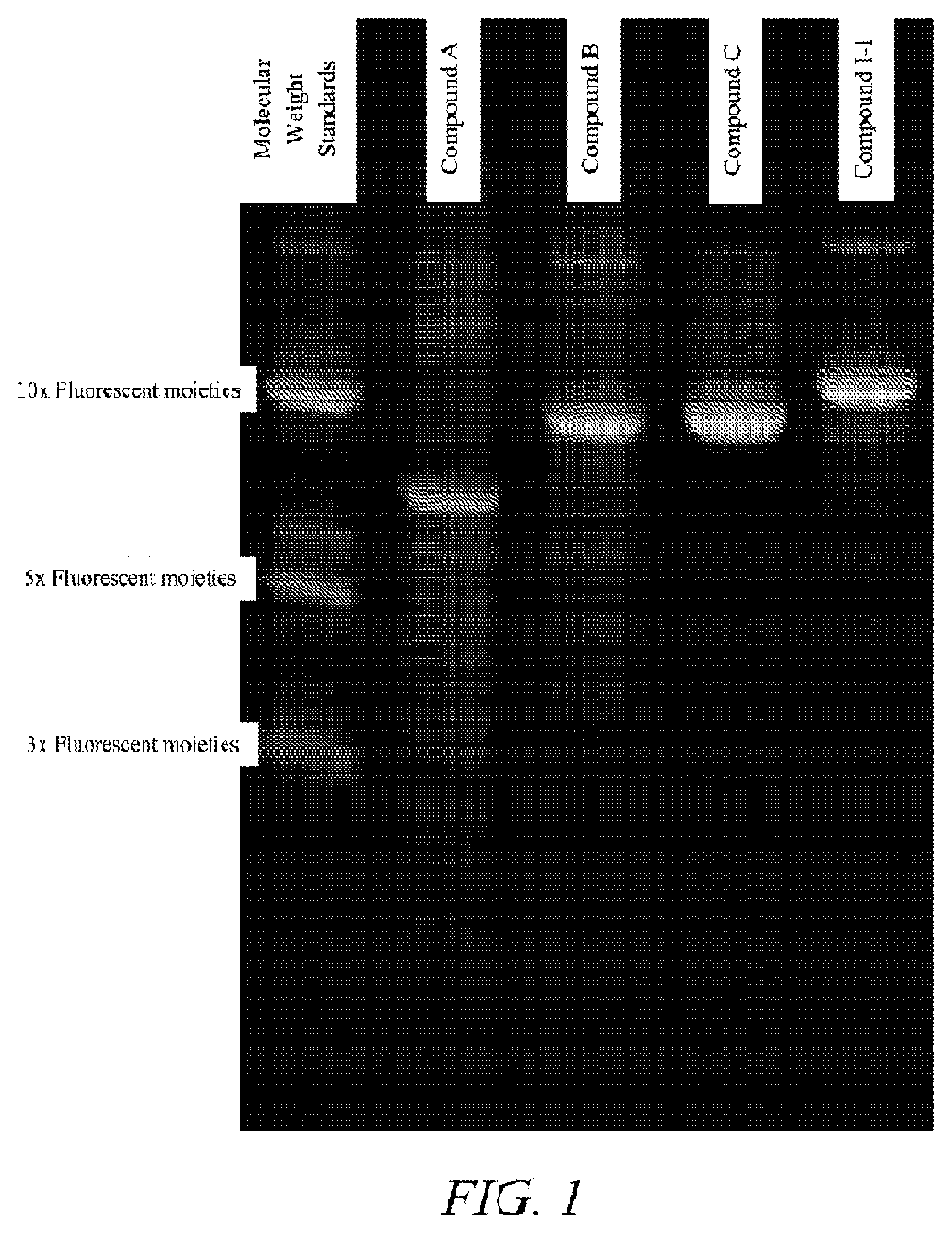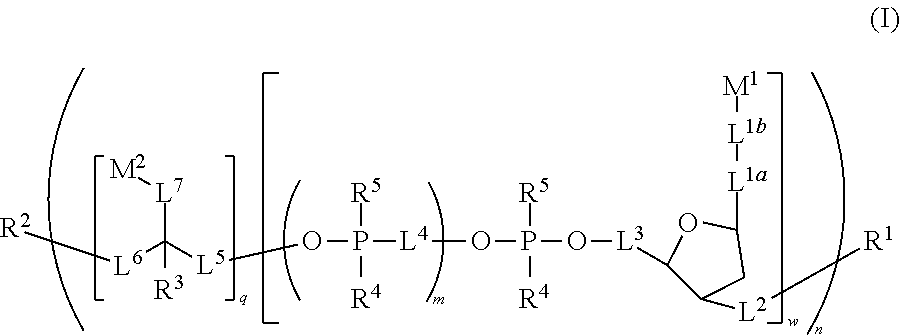Polymeric dyes with linker groups comprising deoxyribose
a technology of polymeric dyes and linker groups, which is applied in the direction of instruments, organic chemistry, sugar derivatives, etc., can solve the problems that the brightness of known dimeric and polymeric dyes has not been increased the desired
- Summary
- Abstract
- Description
- Claims
- Application Information
AI Technical Summary
Benefits of technology
Problems solved by technology
Method used
Image
Examples
example 1
Synthesis of Compound I-1
Stock Solution Preparation
[0326]Borate buffer prepared at 250 mM, pH 10
Fluorscein-NHS solution prepared at 350 mM (300 mg in 1.35 mL DMSO:acetonitrile at 25:75)
[0327]Compound I-1 was prepared on the DNA synthesizer via solid support using standard DNA synthesis techniques (i.e., DMT protected 2-cyanoethyl phosphoramidite). The polymer was removed from the solid support with ammonium hydroxide and lyophilized to a paste. 250 mg aliquots were reconstituted in water. A small aliquot was removed and serial dilutions were prepared in 100 mM NaCO3 at pH 9 to determine concentration (A 263 ε=10,000). Final stock concentration was found to be 14.5 mM.
Dye Coupling Reaction
[0328]In 50 mL centrifuge tube equipped with magnetic stir bar was placed water (1.110 μL), borate buffer (1.800 μL), Compound I-1 polymer solution (466 μL), acetonitrile (137.5 μL), triethylamine (313 μL) and fluorescein-NHS solution (675 μL). The tube was wrapped in aluminum f...
example 2
Synthesis of Compound I-2
Stock Solutions
[0330]Borate buffer was prepared as described in Example 1
300 mM Fluorscein-NHS solution was prepared in DMSO
[0331]Compound I-2 was prepared on the DNA synthesizer via solid support using standard DNA synthesis techniques (i.e., DMT protected 2-cyanoethyl phosphoramidite). The polymer was removed from the solid support with concentrated ammonium hydroxide and lyophilized to a paste. 20 mg was reconstituted from water and a small aliquot was removed, serial dilutions were prepared in 100 mM NaCO3 at pH 9 to determine concentration (A 263, ε=10,000). Final stock concentration was found to be 11.6 mM.
Dye Coupling Reaction
[0332]In a 200 μL micro-centrifuge tube was placed water (10 μL), borate buffer (20 μL), Compound I-2 polymer solution (2.2 μL), magnesium chloride solution (5.4 μL), DMSO (6.9 μL), fluorescein-NHS solution (5.6 μL). The tube was vortexed and allowed to stand overnight. The mixture was...
example 3
Flow Cytometry Method and Applications
[0333]A general flow cytometry workflow includes the following steps:
[0334]1. Culture and visually observe cells for signs of metabolic stress and / or use fresh, induced, or simulated cells.
[0335]2. Dilute dye compounds to working volumes.
[0336]3. Harvest and prepare cells without killing or inducing apoptosis.
[0337]4. Centrifuge and wash cells with appropriate buffer.
[0338]5. Perform cell counts using hemocytometer and trypan blue exclusion.
[0339]6. Centrifuge and wash cells
[0340]7. Adjust cell density to test size
[0341]8. Apply dye (pre-dilution) or other co-stains of interest.
[0342]9. Incubate the cell / stain / dye mixture.
[0343]10. Centrifuge and wash cells with appropriate buffer.
[0344]11. Re-suspend cells in acquisition buffer.
[0345]12. Acquire cell data by flow cytometry.
[0346]The general workflow described above can be modified according to specific applications. Some modifications for specific applications are described below.
Live / Dead Disc...
PUM
| Property | Measurement | Unit |
|---|---|---|
| wavelength | aaaaa | aaaaa |
| pH | aaaaa | aaaaa |
| structures | aaaaa | aaaaa |
Abstract
Description
Claims
Application Information
 Login to View More
Login to View More - R&D
- Intellectual Property
- Life Sciences
- Materials
- Tech Scout
- Unparalleled Data Quality
- Higher Quality Content
- 60% Fewer Hallucinations
Browse by: Latest US Patents, China's latest patents, Technical Efficacy Thesaurus, Application Domain, Technology Topic, Popular Technical Reports.
© 2025 PatSnap. All rights reserved.Legal|Privacy policy|Modern Slavery Act Transparency Statement|Sitemap|About US| Contact US: help@patsnap.com



